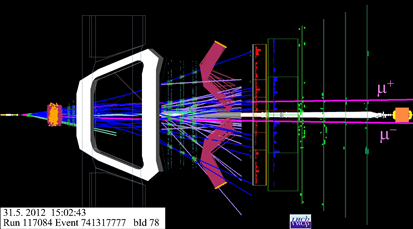[ Branching ratio B0s →μμ = (3.2+1.5-1.2)x10-9 ]
The LHCb Collaboration has presented today at the Hadron Collider Particle Symposium in Kyoto the result of the branching ratio measurement of the B0s meson decay into μ+μ– pair to be (3.2+1.5-1.2)x10-9. Both experimental and theoretical physicists were impatiently waiting for this result, an important milestone of the LHCb program. The significance of the measurement is 3.5σ and therefore is classified as the first evidence for the B0s →μμ decay. The result is in agreement with the Standard Model prediction of (3.54±0.30)x10-9 (for experts: this number takes into account a correction to the value (3.23±0.27)x10-9 due to the finite width difference of the B0s system). LHCb physicists had previously presented 5 March 2012 the lowest published limit of 4.5×10-9 for this decay, which allowed to squeeze strongly the parameters of supersymmetric extensions of the Standard Model (SUSY) – see 30 March 2012 news. The measurement presented today squeezes the parameter space even more.
The total 1.0 fb-1 of data taken in 2011 and 1.1 fb-1 of the data accumulated this year were used to obtain this result. A special event selection (BDT for experts) was used to classify data into bins with different ratios of B0s →μμ decays and background contributions. The μ+μ– invariant mass spectrum for the bins with the smallest background contribution is shown in the left image. The solid blue line shows that the data distribution presented as black dots is well understood and can be separated into different components presented with the help of different colour lines. The dashed red narrow distribution shows the B0s →μμ contribution around the B0s mass of 5366 MeV/c2.
The green dashed distribution shows a possible contribution from the B0 →μμ contribution around the B0 mass of 5280 MeV/c2. Within the Standard Model the branching ratio for this decay is expected to be about 30 times smaller than that for the B0s decay. A small excess of data over the background and Standard Model rate is observed, but is consistent with the Standard Model expectation. LHCb physicists have set a limit of 9.4×10-10 for this branching ratio.
click the image for higher resolution
A typical B0s →μμ decay candidate event is shown above. The two muon tracks from B0s decay are seen as a pair of purple tracks traversing the whole detector in the left image above. The right image shows the zoom around the proton-proton collision point, origin of many particle tracks. The two muon purple tracks originate from the B0s decay point located 14 mm from the proton-proton collision.
The precision of these results will be improved using an additional 1 fb-1 of data or more that will be available by the end of this year thanks to the strong and continuous support from the LHC operations team for the LHCb physics program.
More details can be found in the LHCb presentation in Kyoto and in the LHCb paper here and also in the CERN seminar. Read also the CERN Bulletin article in English and French, the CERN Courier article, the CERN Quantum Diaries blog in English and French and in the Scientific American blog.



